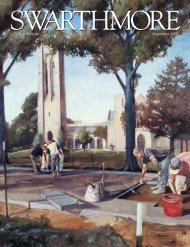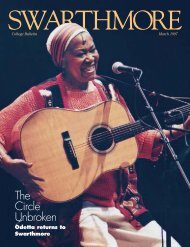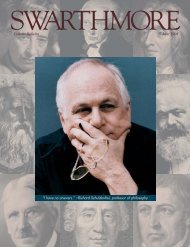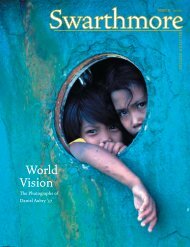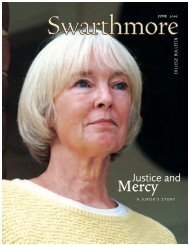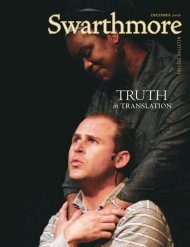america
Swarthmore College Bulletin (September 2006) - ITS
Swarthmore College Bulletin (September 2006) - ITS
You also want an ePaper? Increase the reach of your titles
YUMPU automatically turns print PDFs into web optimized ePapers that Google loves.
A s k t h e{ R i g h t }Q u e s t i o n sCHARLES BENNETT ’77 CONNECTS THE DOTSBETWEEN MEDICINE AND PUBLIC POLICY.By Dana Mackenzie ’79At Swarthmore, Charles Bennett had several heroes.One was the late Franklin and Betty Barr Professor of EconomicsBernard Saffran—a hero to many students. “I had him as a microeconomicsteacher in an honors seminar,” Bennett says. “Bernie wasalways about being careful with your thinking. He pushed me tothink about the creative aspects of what you are doing.” A secondidol was a fellow mathematics major, Dave Bayer ’77 (see “BeautifulMath,” June 2002 Bulletin), who exemplified for Bennett what creativethinking meant.“What I learned during my years at Swarthmore was that the creativepeople were the ones who could ask the right questions,” Bennettsays. He was good at answering questions—good enough tograduate with high honors. At the time, though, he found it frustratingthat he could not figure out the right questions to ask, the wayBayer could.But something must have rubbed off on Bennett, now a professorof medicine in the division of hematology and oncology atNorthwestern University’s Feinberg School of Medicine. There, hehas founded one of the country’s foremost centers for investigatingadverse drug reactions. The center’s success is based on asking theright questions about drug safety. Why did this patient get seriouslyill after taking drug X? How many similar cases have been reported?How many cases have not been reported because no one noticed theconnection? And how can we track them down?In 2001, Bennett received funding from the National Institutesof Health to develop the academic watchdog group RADAR. Theacronym stands for Research on Adverse Drug Events and Reports(with some poetic license). RADAR now has eight full-time staffmembers and about 45 collaborators. Although the Food and DrugAdministration (FDA) is charged with oversight of the nation’spharmaceuticals, Bennett insists that the two are not in competition.“We’re not going to be better [than the FDA], but we can becomplementary,” he says. The FDA’s drug safety program could becompared to a huge network of weather sensors; every year, itreceives 250,000 adverse event reports associated with thousandsof different medications. In contrast, RADAR doesn’t evaluate everygust of wind—it looks for big storms. Bennett’s group investigatesprimarily cancer drugs, with side effects that have been either fatalor required major medical intervention. The drugs they investigateare market leaders, usually with hundreds of millions of dollars insales. So far they have found 16 drugs that fit this profile.As so often happens in science, Bennett got interested in adversedrug reactions because of a personal experience. “My father’s bestfriend was admitted to Northwestern with a very rare disease calledthrombotic thrombocytopenic purpura [TTP],” he says. Discoveredin 1924, TTP is named for the purplish spots (purpura) that appearon the skin of its victims, due to ruptured blood vessels. If leftuntreated, it kills 90 percent of its victims within days. It was notuntil 1992 that a lifesaving treatment was identified. With thistreatment, emergency filtering of the patient’s blood, the mortalityrate for TTP is now 10 percent. But fortunately, TTP is rare, affectingroughly one person in a million.Bennett’s family friend survived, but he couldn’t stop wonderingwhy she had come up on the wrong end of that one-in-a-million lottery.As a hematologist/oncologist, he knew the right people to ask.“I told other doctors her story, and several said they had hadpatients with the same diagnosis,” he says. “They had all taken thesame drug 2 weeks before they got sick.” It was a drug called Ticlid,an anti-clotting medication for people at risk of strokes or heartattacks. Within 3 months, Bennett had obtained information on 60patients with TTP associated with Ticlid, 20 of whom had died. Forpatients on Ticlid, he estimated that the odds of getting TTP wereabout one in 1,600. It was uncommon enough that it had not beenreported previously—but far too common for comfort.Bennett’s report, published in 1998, caused an earthquake in thelucrative market of heart-attack medications. Roche, the companythat makes Ticlid, was forced by the FDA to write a “Dear Doctor”letter to physicians, describing the risk of TTP. The bottom droppedout of the market for Ticlid, which was replaced by a competitor’sdrug, Plavix—now the second-leading drug in the world in dollarsales. (Ironically, in 2000, Bennett reported in the New EnglandJournal of Medicine that Plavix caused TTP as well—just not as frequently.The manufacturers of Plavix also sent a “Dear Doctor” letterto physicians.)september 2006 : 19



